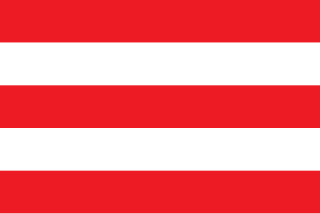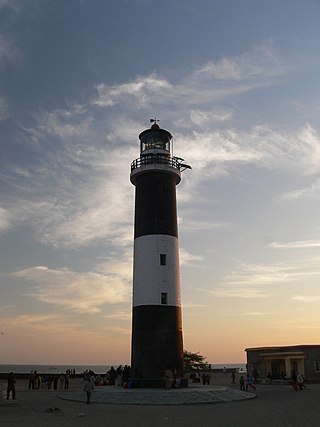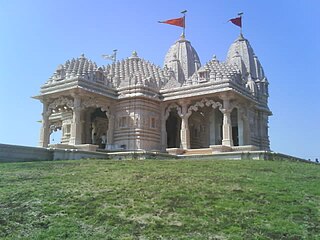
Kathiawar is a peninsula, near the far north of India's west coast, of about 61,000 km2 (23,500 sq mi) bordering the Arabian Sea. It is bounded by the Gulf of Kutch in the northwest and by the Gulf of Khambhat in the east. In the northeast, it is connected to the rest of Gujarat and borders on the low, fertile hinterland of Ahmedabad. It is crossed by two belts of hill country and is drained radially by nine rivers which have little natural flow aside from in monsoon months, thus dams have been built on some of these. Kathiawar ports have been flourishing centres of trade and commerce since at least the 16th century.

Saurashtra, also known as Kathiawar, is a peninsular region of Gujarat, India, located on the Arabian Sea coast. It covers about a third of Gujarat state, notably 11 districts of Gujarat, including Rajkot District. It was formerly a state of India before it merged with Bombay state. In 1961 it separated from Bombay and joined Gujarat.

Jamnagar is a city and the headquarters of Jamnagar district in the Indian state of Gujarat. The city lies just to the south of the Gulf of Kutch, some 337 kilometres (209 mi) west of the state capital, Gandhinagar.

Memoni is an Indo-Aryan language spoken by Kathiawari Memons, from the Kathiawar region of Gujarat, India. Memon from Okha Port, Kutch and some other communities from Kathiawad also use Memoni at their homes.

Nawanagar was an Indian princely state in the historical Halar region, located on the southern shores of the Gulf of Kutch. It was ruled by the Jadeja Rajput dynasty and became a part of newly formed India. Its capital city was Nawanagar city, now known as Jamnagar. It had an area of 3,791 square miles (9,820 km2) and a population estimated at 336,779 in 1901. Its rulers, who use the title of "Jam Saheb" are of the same clan as the Rao of Kutch. They were entitled to a 13-gun salute. The state flag was a rectangular red flag with a white elephant, near and facing the hoist. During the British, the state was part of the Kathiawar Agency, within the Gujarat Division of Bombay Presidency.

Jamnagar District is a district of Gujarat in Western India. Its headquarters are located in the eponymous city of Jamnagar. It hosts the production facilities of large Indian companies such as Reliance. Among its attractions are several palaces, a Marine National Park and a Bird Sanctuary, known as Khijadiya Bird Sanctuary. In 2013, Devbhoomi Dwarka district was carved out of the western part of the district.
Dhrangadhra is a town, taluka headquarters and a municipality in Surendranagar district in the state of Gujarat, India. During the period of the British Raj, the city was the capital of Dhrangadhra State, one of the eight first-class princely states of the Kathiawar Agency in the Bombay Presidency.

Halar (Haalaar) is a historical region of western India, located by the Gulf of Kutch coast on the northwestern area of Nawanagar, now Jamnagar, in Gujarat State, on Saurashtra peninsula, roughly corresponding to the present Jamnagar District, Devbhumi Dwarka district, Morbi District and Rajkot District.

Pirotan Island is an island in the Marine National Park, Arabian Sea. It is located 12 nautical miles (22 km) off the coast, Jamnagar District of Gujarat state, India. It consists of mangroves and low-tide beaches, and has an area of 3 square kilometres. Rozi island is located about 10 kilometres to the southeast.

Mundra is a census town and a headquarter of Mundra Taluka of Kachchh district in the Indian state of Gujarat. Founded in about the 1640s, the town was an important mercantile centre and port throughout its history. Mundra Port is the largest private port in India.

The Sainik School, Balachadi, in Jamnagar, Gujarat, is one of the leading Sainik Schools in the chain of Sainik Schools. It is one of the outstanding boarding schools for public education in Gujarat. It was established in July 1961 by the then Honorable Minister of Home Affairs, Shri Lal Bahadur Shastri. It is an elite English medium, fully residential boarding school for boys and girls, providing premium public education, with a military bias, up to 10+2 stage, as per the Central Board of Secondary Education.

Sir Digvijaysinhji Ranjitsinhji Jadeja was the Maharaja Jam Sahib of Nawanagar from 1933 to 1966, succeeding his uncle, the famed cricketer Ranjitsinhji.

Indo-Polish relations are the bilateral relations between the Republic of Poland and the Republic of India. Historically, relations have generally been friendly, characterised by understanding and cooperation on an international front.

Koteshwar is a small village and the location of an ancient Shiva temple. It located near the mouth of Kori Creek, in the west of Kutch district of Gujarat, India.
Bhuvad is a village of Ahir [Zaru] And Rathod or rathore Rajput Kshatriya in Anjar Taluka of Kutch district of Gujarat, India.

Kera is a village in Bhuj Taluka of Kutch district of Gujarat, India.this historical town was ruled by the jadeja's before independence in 1947. This historical town has several places of interest; the most important part of the town's history the Darbar gadh, the ruins of an old fort and Shiva temple, and the shrine of a Muslim saint Ghulam Ali.

Makaji Meghpar is a village and former chiefdom of Hardhrol Jadeja chieftains in the Jamnagar district of Gujarat, India. It was founded in 1754 by Makanji Jadeja of Dhrol State. Gujarati writer Harilal Upadhyay was from the village. The people are mainly Jadeja Rajputs with some Brahmins, Patels and Dalits.

The Battle of Bhuchar Mori, also known as Battle of Dhrol, was fought between the army of Kathiawar led by Nawanagar State and the Mughal army at Bhuchar Mori plateau near Dhrol, Saurashtra. It was meant to protect Muzaffar Shah III, the last Sultan of Gujarat Sultanate who had taken asylum under Jam Sataji of Nawanagar after his escape from the Mughal emperor Akbar. It was fought in July 1591. The Kathiawar army included the armies of Junagadh who betrayed Nawanagar and joined the Mughal army at last. The battle led to a large number of casualties on both sides. The battle resulted in the victory of the Mughal army.
The Memorial Pillar located in Valivade is in memory of over 5000 Polish refugees who escaped to India during World War II and were given shelter in the area. Poland''s Deputy Foreign Minister Marcin Przydacz unveiled the pillar on 14 September 2019.
Kira Banasińska (1899-2002) was the wife of Eugeniusz Banasiński, the first Polish Consul-General of Poland in Bombay. She was a representative of the Polish Red Cross in India. Kira cared for and helped in rehabilitating the lives of several thousand Polish children, women and old people who were refugees from Russia, who were accommodated during World War II with local help in India.
















